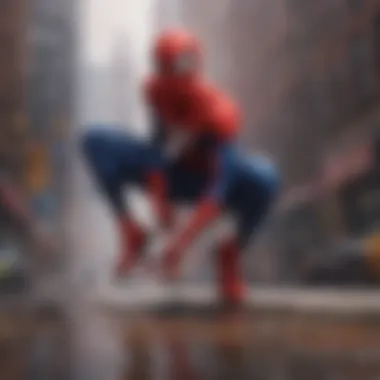Exploring the Depths of Spider-Man: Into the Spider-Verse


Intro
Spider-Man: Into the Spider-Verse is a landmark film that redefined animated superhero storytelling. It offered a fresh take on the Spider-Man lore, incorporating new dimensions, characters, and art styles. This movie not only narrates the journey of Miles Morales but also connects with wider themes of identity and heroism. This analysis will unpack the unique elements that contributed to the film's appeal and significance within the Spider-Man franchise.
Spider-Man Character Analysis
Background
Spider-Man's origin is rooted in his creation by Stan Lee and Steve Ditko in 1962. Peter Parker was an ordinary teenager, biten by a radioactive spider that granted him superpowers. Over decades, Spider-Man evolved through comic books, television shows, and films, becoming an iconic figure in popular culture. Into the Spider-Verse marks a culmination of these years of storytelling, introducing an alternative Spider-Man in Miles Morales, a character who resonates with a multicultural audience.
Powers and Abilities
Spider-Man is renowned for his agility, spider-sense, and wall-crawling abilities. In Into the Spider-Verse, Miles reveals additional powers unique to his genetics, such as invisibility and electrical shock abilities. These powers significantly influence his character development, showcasing how he navigates the responsibilities that come with being a hero.
Character Development
Miles Morales' journey is one of self-discovery and growth. Initially unsure of his place in the Spider-Man legacy, he faces challenges that test his resolve. Key moments, such as the tragic loss of Peter Parker and his efforts to embrace his identity, provide depth to his character. Through his experiences, viewers witness a transformation from a reluctant hero to a confident Spider-Man.
Cultural Impact
Spider-Man: Into the Spider-Verse pushed the boundaries of animation. Critics praised its visual style, combining various animation techniques to breathe life into the story. The diverse cast not only engages various demographics but also carries messages about empowerment and acceptance. The movie's success sparked conversations around representation in media and the importance of diverse superheroes.
Movie Reviews
The film received acclaim for its powerful storytelling and emotional depth. Audiences connected with the film's themes of responsibility, heroism, and community. The voice acting, led by Shameik Moore as Miles Morales and Jake Johnson as Peter B. Parker, added nuanced performances that resonated across age groups. The animation itself deserves notable mention for its innovative approach, seamlessly blending comic book aesthetics with motion graphics.
"In every universe, there is a Spider-Man. The story speaks to the universal journey of becoming one’s true self."
Epilogue
Spider-Man: Into the Spider-Verse stands as a unique entry in superhero films. Its ability to connect with varied audiences through relatable themes and innovative animation reinforces its role in the Spider-Man legacy. While exploring Miles Morales’ story, the film transcends typical superhero narratives, offering a fresh perspective that celebrates diversity and individual growth.
Prelude to Spider-Man: Into the Spider-Verse
The significance of Spider-Man: Into the Spider-Verse in contemporary animation and superhero storytelling cannot be overstated. This film represents a substantial departure from traditional narratives and aesthetics associated with superhero movies. Through its imaginative storytelling, it sets new standards for character development and visual innovation. Understanding this film entails an exploration of the Spider-Verse concept, which introduces a multitude of Spider-Man versions, each with distinct backgrounds and storylines.
This article will dissect the layers of this film, highlighting its value in reshaping how narratives are structured in the superhero genre. We will analyze critical elements such as its production history, the innovative animation styles utilized, and the cultural impact that resonates beyond the screen.
Overview of the Spider-Verse Concept
The Spider-Verse introduces a multiverse where various incarnations of Spider-Man coexist. Each version reflects different attributes, backgrounds, and experiences, adding depth to the character of Spider-Man itself. This concept allows the narrative to explore multiple perspectives, which is refreshing in a genre often dominated by linear storytelling.
For instance, the film features Miles Morales as the primary protagonist, who navigates his journey of becoming Spider-Man while dealing with challenges that are distinct to his identity as a biracial teenager. Alongside him are other Spider-People, such as Peter B. Parker, Spider-Gwen, and even Spider-Ham. The diversity within this set of characters enriches the viewing experience and makes the narrative universally relatable.
Release and Production Background
Spider-Man: Into the Spider-Verse was released on December 14, 2018. The film was produced by Sony Pictures Animation in association with Columbia Pictures and Marvel. Led by directors Bob Persichetti, Peter Ramsey, and Rodney Rothman, the production aimed to create an unconventional animated film that stood out in a crowded market of superhero films.
The film underwent a rigorous production process, which included a unique blend of animation styles to highlight the comic book origins of the Spider-Man character. The creative team also focused on integrating both traditional and digital animation techniques, resulting in a distinctive visual aesthetic that captures the essence of comic book art. This commitment to animation innovation has been a pivotal factor in its acclaim.
In essence, Spider-Man: Into the Spider-Verse is not merely an animated film, but rather a groundbreaking entry in the superhero film landscape that champions diversity, creativity, and innovation. Its ability to blend storytelling, artistic design, and cultural relevance makes it a seminal work in the genre.


The Narrative Structure of the Film
The narrative structure of Spider-Man: Into the Spider-Verse is crucial for understanding how the film resonates with its audience. A well-crafted storyline not only captivates viewers but also builds emotional depth, allowing for a connection to the complex characters. The film employs a multi-dimensional narrative that explores the themes of identity, heroism, and the idea that anyone can wear the mask. This exploration is delivered through a carefully woven plot that keeps viewers engaged while emphasizing the rich tapestry of the Spider-Verse.
Plot Summary
Spider-Man: Into the Spider-Verse introduces Miles Morales, a teenager who lives in New York City and strives to find his place in the world. Following a fateful encounter with the original Spider-Man, Peter Parker, Miles gains spider-like abilities. After Peter's tragic death, Miles meets other versions of Spider-People from parallel universes, including Spider-Gwen, Spider-Man Noir, Spider-Ham, and Peni Parker.
The film's central plot revolves around the threat posed by Wilson Fisk, also known as Kingpin, who seeks to use a dimensional collider to access alternate universes. The stakes escalate as Miles learns to harness his powers and takes the responsibility of becoming the new Spider-Man. Confronting internal and external conflicts, he must team up with the other Spider Heroes to thwart Kingpin's plans and protect his universe.
This summary presents a plot rich in adventure and emotional growth. The transitions between different Spider-People's narratives contribute to a multifaceted storytelling experience. Each character brings their unique perspective, making the plot both complex and engaging.
Themes and Motifs
The film is layered with thematic elements that elevate the narrative beyond conventional superhero fare. One prominent theme is the concept of identity—Miles grapples with balancing his personal life with the responsibilities of being Spider-Man. The motif of "anyone can wear the mask" serves as a powerful message, reinforcing inclusivity and representation.
Another significant theme is mentorship. The dynamic between Miles and his reluctant mentor, Peter B. Parker, highlights growth, failure, and resilience. Through their relationship, the film explores how guidance can shape one’s path.
Additionally, the visuals support the narrative with vibrant colors and distinct styles, reflecting the diversity of the characters. The animation itself becomes a narrative tool that enhances the storytelling experience.
"In a world of infinite possibilities, the film captures the essence of heroism and the universality of struggle, emphasizing that one does not need to be perfect to make a difference."
In summary, the narrative structure of Spider-Man: Into the Spider-Verse provides a profound exploration of complex ideas using a captivating plot and relatable themes. This approach offers a deeper understanding of Spider-Man's legacy and the broader implications of heroism in society, engaging audiences throughout its runtime.
Character Analysis
Character analysis is crucial to understanding Spider-Man: Into the Spider-Verse. The film does not merely focus on its main hero, Miles Morales. It presents a rich tapestry of personalities that contribute to its narrative depth and emotional resonance. Characters like Peter B. Parker, Spider-Gwen, Spider-Man Noir, Spider-Ham, and Peni Parker each add unique perspectives and dynamics that enhance the story. This section will explore these characters in detail, showcasing their roles in the Spider-Verse and how they embody various themes of identity, mentorship, and heroism.
Miles Morales: The New Spider-Man
Miles Morales embodies the next generation of Spider-Man. His background as a half-Puerto Rican, half-African American teenager brings diversity into the Spider-Man legacy, transforming it while maintaining its core values. Miles’s journey from an unsure youth to a confident hero illustrates the challenges of growing up, particularly in today’s environment. His struggles with self-identity and pressure to live up to his role resonate with many viewers.
Miles’s unique powers, such as camouflage and a venom strike, set him apart from other Spider-Men and serve as narrative devices that symbolize his different perspective and underdog status. His relationship with other characters, especially Peter B. Parker, serves to show his evolution and the theme of mentorship under adversity.
Peter B. Parker: Mentor and Anti-Hero
Peter B. Parker serves as a layered mentor figure but also embodies the anti-hero archetype. Unlike the traditional, confident Spider-Man, Peter B. is depicted as somewhat weary and struggling with failure. His flaws make him relatable, as he deals with the responsibilities of being a Spider-Man while facing personal challenges.
His mentorship of Miles is pivotal. He represents a possible future for Miles if he fails to embrace his true potential. The dynamic between the jaded mentor and the eager student presents a richer storytelling experience. This layer of complexity allows audiences to engage with Peter B. beyond mere mentorship; he represents a cautionary tale of what can happen when one loses sight of their heroic responsibilities.
Supporting Characters in the Spider-Verse
Spider-Gwen
Spider-Gwen, or Gwen Stacy, introduces a fresh take on the Spider-Man narrative by portraying a world where she is the one bitten by the radioactive spider. Her key characteristic is her strong-willed nature and determination to forge her path as a hero. This choice is beneficial for the article as it showcases female empowerment within a genre often dominated by male figures. Additionally, Spider-Gwen's unique ability to resonate with both comic readers and general audiences provides diverse representation that enriches the overall theme of heroism.
Gwen's visual appeal and distinct style further enhance her character's recognition. Her role complements Miles's journey, symbolizing the idea of duality and partnership amidst the chaos of the multiverse.
Spider-Man Noir
Spider-Man Noir adds a fascinating layer to the film through his dark, gritty perspective. This version of Spider-Man hails from a 1930s alternate universe. His character embodies a key characteristic of determination and resourcefulness, making him a compelling addition to the film’s roster of heroes. The popularity of Spider-Man Noir stems largely from his unique storyline that diverges from typical superhero tropes.
His unique feature is the noir aesthetic, which contrasts sharply with the film's vibrant visuals. This difference provides a refreshing narrative shift, allowing audiences to explore varying styles and approaches to heroism in a single film.


Spider-Ham
Spider-Ham, a parody character, serves as comic relief but also contributes to the overarching narrative. His child-like innocence and humor make him appealing across age groups. This character showcases an important aspect of the film: not all heroes are serious, and sometimes humor is necessary, even in dire circumstances.
The uniqueness of Spider-Ham lies in his cartoonish animation style, which stands out against the film's primary visual narrative. This contrast can be viewed as an advantage in adding variety, though some may argue it detracts from the film's earnest tones.
Peni Parker
Peni Parker introduces a different cultural background by depicting a young girl from the future who pilots a robotic suit powered by a spider. Her key characteristic is intelligence, which sets her apart from other characters. This aspect is beneficial in terms of representation, showcasing young women in STEM fields as strong heroine figures in a superhero story.
The unique feature of Peni's character is her integration of anime influence, which attracts a wide audience demographic. However, her appearance may be a disadvantage to those unfamiliar with anime culture, possibly limiting her relatability to a broader audience.
Each of these characters plays a vital role in Spider-Man: Into the Spider-Verse, enriching the film's narrative complexity and thematic depth.
Artistic Innovations and Animation Style
The Artistic Innovations and Animation Style of Spider-Man: Into the Spider-Verse plays a crucial role not only in its storytelling but also in setting it apart from other animated films. This section will explore how the film utilizes unique visual elements and pioneering animation techniques that contribute to its overall impact. By doing so, it highlights a new direction for animated superhero movies, merging artistry and technology seamlessly.
Visual Aesthetics and Design
The visual aesthetics of Spider-Man: Into the Spider-Verse are both striking and deeply intertwined with the narrative. The film employs a comic book style of animation that immerses the viewer in a world that feels both familiar and fresh. Each frame seems to pulsate with life, as if it has jumped straight off the pages of a comic book. Here's what makes the visual design significant:
- Color Palette: The color palette is vibrant; it captures the essence of the Spider-Man universe. Bright colors reflect the personality of characters, while darker tones amplify moments of gravity and emotion.
- Character Design: Each Spider-Person features a distinct design that represents their individual origins, from Miles Morales to Spider-Man Noir. These variations create a visual diversity that echoes the film’s theme of multiple identities.
- Use of Comic Techniques: Techniques like halftone dots, onomatopoeia captions, and the occasional inclusion of comic frames give the audience an authentic comic experience. This setup is innovative, challenging traditional animation conventions.
The overall aesthetics are paramount in guiding the audience’s perception and emotional journey throughout the film. The blend of traditional hand-drawn techniques with computer-generated elements creates a unique viewing experience.
Animation Techniques Used
Spider-Man: Into the Spider-Verse not only excels in artistic style but also employs groundbreaking animation techniques. These methods push the boundaries of traditional animation and open up possibilities for future projects. Some noteworthy techniques include:
- Frame Rate Variation: The film utilizes a unique frame rate for different characters, with main characters animated at a higher frame rate to give a smoother appearance. In contrast, secondary characters often have a slightly lower frame rate, which adds depth to the storytelling.
- 3D and 2D Integration: It combines 3D animation with 2D art styles, giving characters a dimensional feel while retaining a flat look reminiscent of comic books. This interaction heightens the visual storytelling.
- Dynamic Movement: Action scenes are executed with a fluidity that intertwines with the art style. Each motion feels deliberate and choreographed, creating a sense of rhythm that enhances the viewer's engagement.
The combination of these techniques not only creates visually arresting scenes but also serves to enhance character development and emotional weight. The artistic innovations within the film contribute significantly to its legacy, paving the way for future animated stories that prioritize bold visual creativity.
"The art was not just a backdrop but a part of the emotional journey of the characters, reflecting their struggles and triumphs."
Cultural Impact and Reception
The cultural impact and reception of Spider-Man: Into the Spider-Verse highlights the film's significant role in redefining superhero narratives and animation. Its unique storytelling, aesthetic innovations, and character depth resonate with a wide audience. This section will delve into the critical acclaim and audience reception, showcasing the movie's far-reaching effects on both the film industry and popular culture.
Critical Acclaim and Awards
Spider-Man: Into the Spider-Verse received widespread critical acclaim upon its release. Critics praised its groundbreaking animation style and engaging narrative. The film not only stood out for its artistic merit but also for its ability to weave complex themes into a superhero tale.
- The movie won the Academy Award for Best Animated Feature in 2019. This recognition highlighted the film as a leader in animation, setting a new standard for creativity and storytelling.
- Rotten Tomatoes and Metacritic both rated the film highly, reflecting its positive reception among critics. With a score of over 97% on Rotten Tomatoes, it ranked among the best-reviewed animated films.
- Critics lauded the film for its diverse representation of characters and stories, particularly the focus on Miles Morales, a Black and Latino Spider-Man. This aspect resonated with many viewers, sparking discussions about inclusivity in media.
"In this film, we not only see the multiverse concept but also how relatability can enhance the storytelling of a superhero."
Audience Reception and Influence
Audience reception mirrored the critical acclaim, with many fans and new viewers welcoming the film's fresh approach. Spider-Man: Into the Spider-Verse attracted diverse demographics, including families and younger audiences.
- Box office success was apparent with over $375 million grossed worldwide. The financial performance showcases that there is a strong interest in innovative storytelling.
- The vibrant animation style influenced how subsequent animated projects are approached. Other studios began to experiment with unique visual methods, attempting to capture the success that Spider-Verse achieved.
- Online discussions and fan communities flourished, demonstrating the film's influence. Fans actively engaged on platforms like Reddit and Facebook, sharing fan art, theories, and analyses, which further entrenched the film in contemporary culture.


Overall, the cultural impact of Spider-Man: Into the Spider-Verse significantly contributes to its legacy. The film has not only redefined animation genres but also emphasized the importance of representation and dynamic storytelling in superhero narratives.
The Spider-Man Franchise: Historical Context
The Spider-Man franchise has long been a cornerstone of both comic book culture and modern filmmaking. Understanding its historical context is crucial for appreciating the nuances of Spider-Man: Into the Spider-Verse. The character of Spider-Man, introduced in 1962 by Stan Lee and Steve Ditko, became an instant icon. His relatability and struggles with everyday problems, paired with the burden of heroism, resonated with readers. The ability of Spider-Man to connect emotionally set a precedent for future comic book heroes.
Spider-Man in Comics and Animation
Spider-Man's journey began in comics. His adventures appeared in various series including The Amazing Spider-Man. This series featured intricate plots and powerful character development, drawing in a dedicated readership. Over time, Spider-Man transitioned into animation. Shows like Spider-Man: The Animated Series of the 1990s introduced the character to new audiences. These adaptations made Spider-Man's lore accessible to children and adults alike, while also maintaining the essence of the original comics.
The animated series tackled significant issues like responsibility, grief, and sacrifice. This depth further solidified Spider-Man's reputation as a character who could engage with serious themes while being entertaining. The integration of different animation styles, as seen in the animated shows and movies, has impacted how audiences perceive superhero stories today.
Spider-Man in Cinema Prior to the Spider-Verse
Before Into the Spider-Verse, Spider-Man had already made significant strides in cinema. The early 2000s saw Spider-Man (2002), directed by Sam Raimi, which served as a pivotal moment in superhero film history. This film set a template for how superhero movies could blend action and humor while remaining true to the source material. With performers like Tobey Maguire, it brought a deeper emotional narrative that appealed to a broad audience.
Subsequent films, including The Amazing Spider-Man series, sought to build upon this foundation. However, mixed receptions suggested a need for innovation. By 2018, Spider-Man: Into the Spider-Verse emerged, breaking traditional cinematic norms. This film adopted a distinct animation style, diverse characters, and an ambitious narrative that expanded the Spider-Man mythos. It showcased multiple Spider-People from various universes, encapsulating the franchise's evolution over decades while setting the stage for future storytelling possibilities.
Future of the Spider-Verse
The future of the Spider-Verse represents a significant area of exploration for fans and creators alike. After the successful release of Spider-Man: Into the Spider-Verse, there is a heightened expectation for what comes next in this cinematic universe. The innovative storytelling and unique animation style have raised the stakes, setting a high bar for future productions. In contemplating the direction of this franchise, key elements such as sequels, potential spin-offs, and crossover events offer exciting possibilities for exploration.
Sequel Expectations and Developments
With the acclaim of the original film, the anticipation for sequels is palpable. Producers and writers must navigate the balance between creative innovation and retaining the beloved core aspects that made the first installment successful. There are indications of a sequel in development, which fans eagerly await.
Significant expectations include:
- Expanded Character Arcs: Fans are interested in seeing the growth of Miles Morales and the implications of being Spider-Man.
- New Spider-People: Introducing additional characters from the vast multiverse opens pathways for narrative richness.
- Plot Depth: The sequel might explore more complex themes, building on those established in the original.
The development of the sequel will heavily depend on how effectively these elements are integrated to create a cohesive narrative that resonates with the audience.
Potential Crossovers with Other Universes
In the realm of superhero films, crossovers have become a trend that excites fans. The expansive nature of the Spider-Verse allows for potential connections with other franchises. Imagining characters like Miles Morales interacting with others from the Marvel universe, or even beyond, can create engaging storytelling.
Key considerations regarding crossovers include:
- Maintaining Consistency: Any crossover must ensure that the character integrity and storytelling style remain intact, adhering to what fans have come to love about the Spider-Verse.
- Diverse Character Interactions: The interactions between different characters from various universes could yield compelling plots.
- Expanding the Audience: Crossovers offer a chance to reach wider audiences, introducing new fans to the unique storytelling of the Spider-Verse.
"The Spider-Verse is not just an animated film; it's a narrative kaleidoscope that promises to expand in ways previously unimagined."
With the potential for dynamic storytelling and character interactions, the future of the Spider-Verse is undeniably promising. The developments ahead will play a critical role in determining the legacy of this innovative franchise.
Finale: Legacy of Spider-Man: Into the Spider-Verse
The film 'Spider-Man: Into the Spider-Verse' marks a pivotal moment in the history of animation and storytelling. Its success introduces new possibilities for animated features, particularly in the superhero genre. The film not only redefines how such stories can be told, but it also influences both audiences and creators alike. This legacy is multifaceted, impacting trends in animation, character representation, and narrative complexity.
Enduring Influence on Animation and Storytelling
One of the most significant aspects of this film is its innovative approach to animation. The visual style blends various techniques, creating a unique aesthetic that feels dynamic and fresh. This style employs comic book artistry, including visible ink lines and halftone dots, bringing the comic roots of Spider-Man to life in a novel way. The film's success has inspired other animations, prompting studios to explore bold artistic choices.
Furthermore, 'Into the Spider-Verse' has broadened the narrative scope for storytelling in animated films. By embracing a multiverse narrative, it allows for diverse interpretations of characters, such as Miles Morales, who represents a new generation of Spider-Man. The film’s exploration of identity and heroism resonates with many viewers, showcasing that anyone can wear the mask. Such themes elevate animated storytelling, encouraging deeper emotional connections.
Final Thoughts on Spider-Man's Evolution
Reflecting on Spider-Man's journey, 'Spider-Man: Into the Spider-Verse' contributes to a significant evolution of the character. The film showcases the adaptability of the Spider-Man mythos. It emphasizes newer dimensions of heroism while honoring the origins of the character. As Spider-Man continues to evolve in various media forms, this film stands out as a benchmark in animation and storytelling.
Moreover, this entry signals a shift in how audiences perceive superhero narratives. The incorporation of multiple versions of Spider-Man, each with their struggles and triumphs, democratizes the concept of heroism. As such, it invites audiences to see themselves as part of the broader Spider-Man legacy. The film serves as a reminder that heroes come in many forms and that their stories can be just as varied and complex.
"The legacy of 'Spider-Man: Into the Spider-Verse' lies not only in its artistic achievements but also in its impact on narratives and character representation in animation."







